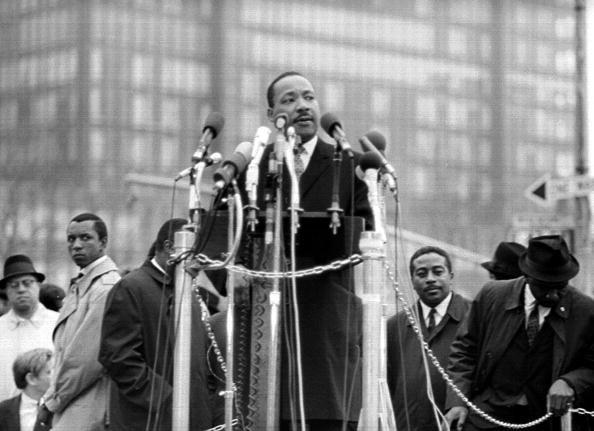
Martin Luther King Jr. was an American pastor, activist, humanitarian, and leader in the African-American Civil Rights Movement. He is best known for his role in the advancement of civil rights using nonviolent civil disobedience based on his personal Christian beliefs. King also helped organize the 1963 March on Washington, where he delivered his famous "I Have a Dream" speech. There, he established his reputation as one of the greatest orators in American history.
In 1964, King received the Nobel Peace Prize for combating racial inequality through nonviolence. In 1965, he and the Southern Christian Leadership Conference helped organize the Selma to Montgomery marches and the following year, he took the movement north to Chicago. In the final years of his life, King expanded his focus to include poverty and the Vietnam War, where he alienated many of his liberal allies with a 1967 speech titled "Beyond Vietnam." In 1968 King was planning a national occupation of Washington, D.C., to be called the Poor People's Campaign, when he was assassinated.
Many people know of Martin Luther King Jr.’s best accomplishment as a leader in the Civil Rights Movement but there are lots of surprises that many people may not know. One of them is that MLK Jr. has about 20 honorary degrees from numerous colleges and universities in the United States and several foreign countries. That is why we have compiled a list of the top seven surprising facts you may not know about MLK Jr.
1. He was born Michael King Jr. after his father, Michael King Sr., but the senior King changed their names to Martin Luther King Sr. and Jr. when Martin Jr. was around 5 years old. By some accounts, King Sr. said that his real name was Martin Luther, but that his mother called him Michael and he didn't know; when he found out, he changed both the names.
2. Even after being declared one of the greatest orators in American history, and beating out Presidents Franklin D. Roosevelt and John F. Kennedy, Martin Luther King Jr. was once just considered an average public speaker. While in grade school, MLK Jr. only received a "C" in public speaking. But he redeemed himself seeing as his "I Have A Dream" speech was ranked first in top speeches of all time.
3. The "I Have a Dream" speech put Martin Luther King Jr. on the FBI’s watch list. A couple of days after the speech, FBI Agent William C. Sullivan wrote a memo calling King Jr. "the most dangerous Negro… in this Nation" due to his incredible influence, which in turn added growth to his following. The FBI then heightened their investigation into King and his civil rights organization, the Southern Christian Leadership Conference.
4. In 1963, Martin Luther King Jr. became the first African-American to be named Time magazine's Man of the Year. Time’s tribute to King included a photograph of the civil rights leader on the magazine’s cover, along with a seven-page feature that included pictures of King during some of the most memorable moments of his civil rights career, including a meeting with President Lyndon B. Johnson and King’s arrest in Birmingham, Alabama, in 1963.
5. At the age of 35, he became the youngest man to have been honored with the Nobel Peace Prize. Presented with a gold commemorative medallion, the Nobel Peace Prize also included a $54,600 check. Dr. King forfeited all of these funds to the continuing efforts of six organizations: the American Foundation on Non-Violence, Congress on Racial Equality (CORE), NAACP, National Council of Negro Women, Student Non-Violent Coordinating Committee (SNNC) and the Southern Christian Leadership Conference (SCLC).
6. There are more than 900 streets named after him in the United States and that number continues to grow. There are also a number of other countries that have honored King, including Italy and Israel. The number of streets named after King is increasing every year, and about 70% of these streets are in Southern states: Alabama, Florida, Georgia, Louisiana, Mississippi, North Carolina, and Texas.
7. King is one of the only non-presidents to have a national holiday in his name, and is the only non-president with a memorial on the National Mall in Washington, D.C. The monumental memorial is located at the northwest corner of the Tidal Basin near the Franklin Delano Roosevelt Memorial, on a sightline linking the Lincoln Memorial to the northwest and the Jefferson Memorial to the southeast.
© 2025 Latin Times. All rights reserved. Do not reproduce without permission.





